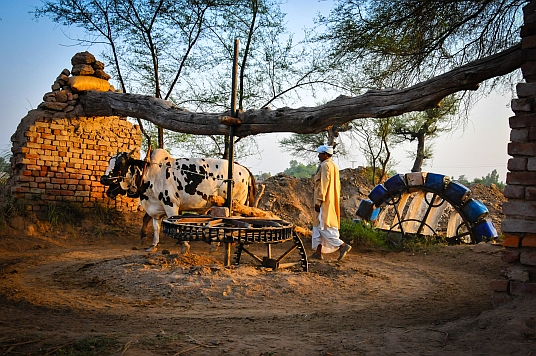Defining the links
October 17 marks the International Day for the Eradication of Poverty. In many communities, access to water is potentially a critical factor in alleviating poverty and enhancing economic growth. Research carried out by the International Water Management Institute (IWMI) focuses on water availability and access to ensure that there is enough water for agriculture and to secure the livelihoods of farmers in the developing world.

Are you poor if you have no water? The answer may seem obvious and, indeed, without any water, no kind of human life is possible. However, some people living in dry countries, such as Australia, are not ‘poor’ in global terms whereas countries with plenty of water, such as Bangladesh, have widespread poverty. Clearly, there are many more factors affecting poverty than simply access to water.
Nevertheless, in sub-Saharan Africa, rural communities with highly seasonal rainfall are frequently impoverished. The opportunity to grow a second crop outside of the rainy season could potentially boost household incomes and lift families out of poverty. Of course, there are other limiting factors, such as access to markets and other resources, but improving smallholder incomes may be a non-starter without water.
So, the issues seem to be straightforward: invest in water management for smallholders. However, investors want figures. Whether governments or nongovernmental organizations (NGOs), they want to be sure that they are getting a good bang for their buck. To date, however, it has been difficult to accurately assess what the returns on investments in agricultural water management might be.
Complex processes and impacts
Now, new research from IWMI attempts to address this issue by proposing a methodology that can assess the development impact of rainwater management innovations through the use of a Rainwater-livelihoods-poverty index (RLPI).
“The index is an indicator composed from multi-dimensional water-related components,” says Kindie Getnet, Research Economist, IWMI. “It is supposed to capture and reflect the role of the complex processes and impacts that will make rainwater management innovations a success for livelihood development and poverty reduction.”
The RLPI is based on five components, including water availability, water accessibility, livelihood strategies, ecological sustainability and resilience to rainfall variability. Each component is broken down into several sub-components. The methodology is further strengthened with participatory household surveys, as a way to relate scientifically generated evidence with empirical evidence and eventually inform farmers’ decisions about adopting rainwater management innovations.
Right interventions
The researchers applied RLPI in Ethiopia’s Diga District, which is heavily characterized by subsistence crop-livestock farming. In this region, Agriculture is mainly rain-fed and the farmers are affected by seasonal water shortages as well as land degradation due to overgrazing. Seasonal water shortages could be addressed through the right rainwater management interventions.
Data was collected from 120 households within the district. The results clearly mirror the lack of livelihood diversification, the problem of soil erosion and vegetation degradation as well as poor resilience to rainfall variability as important constraints. By breaking the results further into the sub-components, one gets a more detailed insight into the situation. For example, in the case of water availability, the index showed that irrigation demands for crops and domestic use are unmet, whereas there is enough water for livestock.
Based on this, the researchers suggest prioritizing investments in these areas that show shortcomings.
“It is important to address these limiting factors to develop livelihoods and reduce poverty,” says Getnet. “Our index may need further improvements and refinements. However, it contributes towards the impact assessment, and can be used for priority setting in planning and implementing rainwater management interventions.”

